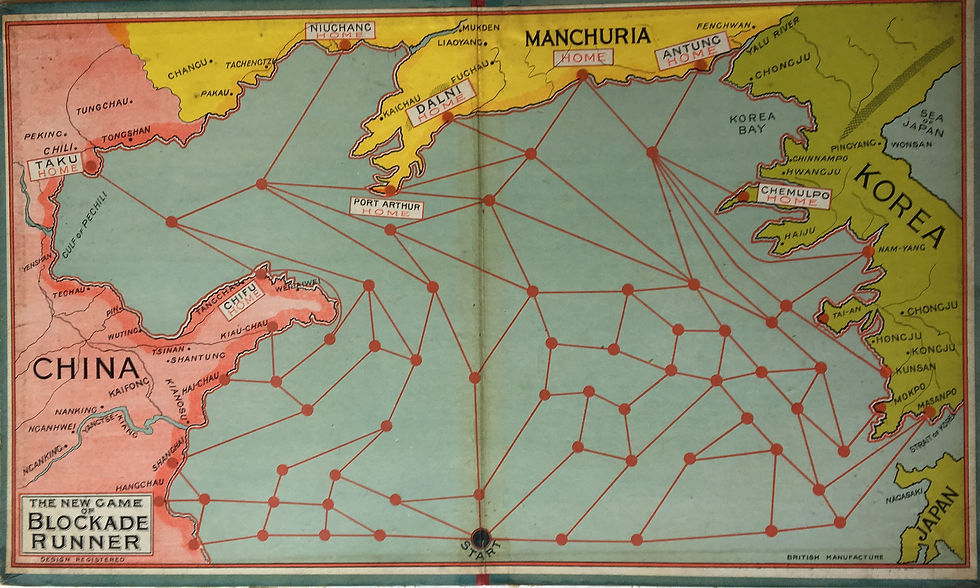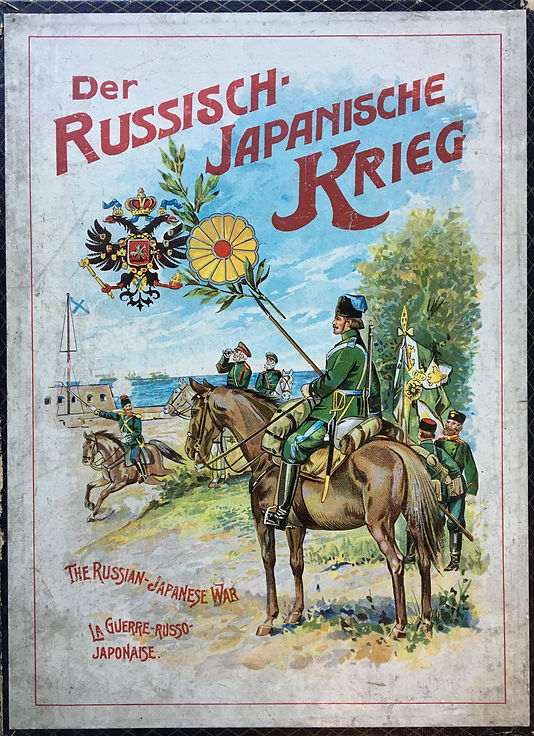The Russo-Japanese War
In March 1861, the Russian corvette Posadnik under Captain Nicolai Birilev had sailed into Tatamura Bay on the island of Tsushima. Its voyage was part of a steady Russian push east. Vladivostok had been establish the year before, but it was ice-bound in the winter. Russia hoped do a deal with Japan for a year-round naval base for its Pacific fleet. The island, half way between Japan and Korea, seemed ideal.
The ship surveyed the bay, but a squabble with local peasants left two of them dead along with any chance of a deal. Russia’s next encounter with Tsushima would prove far more costly.
By 1904, Russia had found another location for its warm-water Pacific base. It leased land from China and set up Port Arthur on a peninsula on the southern coast of Manchuria.
Japan just had wrapped up a war with China in 1895 and had further ambitions. It worried that Russia's presence in Manchuria would encroach on its sphere of influence. Japan offered to recognize Manchuria as in the Russian sphere if Russia would recognize its conquest of Korea.

Russia refused. Japan decided to go to war. On Feb. 8, 1904, the Imperial Japanese Navy raided the Russian port of Vladivostok. They damaged two battleships and a cruiser. Japan then landed troops in Korea without opposition. In April, Russia’s top naval strategist, Vice Admiral Stepan Makarov, tried to break the Japanese naval blockade of Port Arthur with the battleships Petropavlovsk and Pobeda. Both hit mines. Petropavlovsk sank, killing Admiral Makarov. The damaged Pobeda limped back to Port Arthur.
In May, Japan landed on the Liadong Peninsula and besieged Port Arthur. The Russian port was strongly defended, with 50,000 troops, more than 500 guns and deep layers of fortifications. The Japanese had 150,000 troops and slightly fewer guns. The resulting battle was a taste of the hell to come in the trenches of WWI. On Aug. 8-9, Japan penetrated the first belt of fortifications on two hills.

This prompted the remainder of the Russian Pacific Squadron to leave port on Aug. 10 and try to meet up with the ships remaining in Vladivostok. The resulting naval battle scattered the Russian ships and forced most of them to return to Port Arthur. Four days later, other Japanese ships sank a Russian cruiser off southern Korea and forced the remainder of the Vladivostok-based ships back to that port.
The Japanese blockade of Port Arthur prompted this British game in 1904. The New Game of Blockade Runner is a fairly basic game of maneuver. One player starts at the bottom of the board, in the middle of the Yellow Sea and tries to resupply Russian forces by moving pieces to Port Arthur and other “Home” spaces. The Japanese player aims to keep the Russians isolated by blocking such movements.

By the beginning of December, the Japanese land forces around Port Arthur were close enough to shell the anchored Russian fleet. By Dec. 9, only the battleship Sevastopol remained afloat. After the last defending forts fell, the Russian defenders surrendered on New Year’s Eve. More than 6,000 Russians were dead, and some 23,000 were captured, most of them wounded. The Japanese lost 14,000 dead, with about 77,000 more wounded or struck down by illness.
This German game points to what happened on land. It also demonstrates the great interest across Europe created by this first major confrontation between a European and an Asian power. The cover of the game box includes titles in English and French as well as German.
The game is roll-and-move affair that can be played by as many as six players (three Russian and three Japanese).
It is notable for including both land and naval aspects of the conflicts. It also has fine metal figurines of both soldiers and ships.
Players use the soldier figures when traversing land, and exchange them for ships when the route enters an ocean space. That said, the game focuses on the outcome of the land campaign.
Russian tracks cross Manchuria and China before reaching Port Arthur. Japanese players have many more options, some totally by sea, others switching to land through Korea.

The two sides meet twice. The first encounter is space 39, Port Arthur. The second and last encounter is at space 53, Mukden. This is where the final, and bloodiest land battle of the war took place in February 1905. This German game seems to regard that as the decisive meeting, and may have been designed before the subsequent Japanese naval triumph at Tsushima.

The Japanese, of course, published games that reflected their own perspective on the war and celebrated their country’s success. The first year of the war was documented in detail in The Light of Morning Sun, published by the Osaka Asahi newspaper group as an appendix to its issue of January 1, 1905.
The first panel (lower right corner) shows the final meeting between Japanese Foreign Minister Jutaro Komura and the Russian Minister to Japan, Roman Rosen on Feb. 6, 1904. Two days later, the Japanese fleet launched its pre-emptive strike against the Russian Far Eastern fleet in three locations: Port Arthur, Vladivostok and Chemulpo Bay (part of what is now Incheon, South Korea). The formal declaration of war followed later the same day.

Moving counter-clockwise, the first panel shows the battle of Chemulpo Bay. Korea was under Japanese influence but technically neutral. Moored at the port along with the Russian protected cruiser Varyag were warships from France, Britain, Italy and the United States. Japanese forces included six cruisers and three troop ships under Rear Admiral Sotokichi Uryu. Worried about hitting neutral ships if he attacked the Russians in port, Uryu simply sent his three troop transports into the port and had the troops debark – without any fighting.

On the next day, Varyag and the Russian gunboat Korietz decided to make a run for it. They were intercepted outside the port. The gunboat was sunk and the Korietz heavily damaged. It returned to port and was scuttled by her surviving crew.
Space 4 shows the Japanese attempt to block the entrance to Port Arthur on Feb. 24. In a night-time foray, they succeeded in sinking several concrete-filled steamers, but the water proved too deep to make them effective.
Space 7 shows the abortive attempt by the Russian battleships Petropavlovsk and Pobeda to escape the port during the night of April 12-13 and notes the death of Russian Admiral Makarov during the action.
Spaces 8-10 show the steady advance of Japanese land forces during May, 1904. Space 8 shows the Battle of the Yalu River on May 1. This was the first major land battle of the campaign, and the first in decades in which an Asian power defeated a European one.

Space 9 shows the landing at Liaodong and space 10 is a vivid illustration of the assault on Nanshan. The gritty image of troops slogging their way uphill through muddy ground and barbed wire offers an early look at the harsh realities of trench warfare that would become common in WWI.
Space 15 shows the sinking of the Russian cruiser Rurik on Aug. 14. This stemmed from the Pacific Squadron’s attempted breakout from Port Arthur on Aug. 10.
The Russian aim was to have the ships from Port Arthur link up with the squadron based in Vladivostok. However, the Vladivostok squadron was intercepted off the Korean east coast by a larger cruiser squadron under Vice Admiral Hikonojo Kamimura.
The Japanese effectively destroyed the Russian force, sinking Rurik and damaging the other two cruisers so badly that they could not be repaired by the facilities in Vladivostok.
Space 21 shows the news arriving of the surrender of Port Arthur. The Russian offer to surrender was not actually made until Jan. 1, 1905, the day of this game’s publication. However, Japanese forces broke through all of the defending fortresses during the month of December, by digging mines underneath them and blowing them up one by one. Fort Chikuan was destroyed on Dec. 18, Fort Ehrlung on Dec. 28, and Fort Sungshu on Dec. 31.
The newspaper clearly felt that victory was now inevitable and that it was time to celebrate. The caption on the centre space reads: “Honor our Japanese flag, the flag which beat even seething waters in the ocean, the flag which beat even clouds floating amongst mountains. See the light of morning sun. Banzai!”
Worse was to come for the Russians. On Oct. 15, 1904, Russia dispatched 42 ships to relieve Port Arthur. False reports of Japanese torpedo boats prompted fire at British trawlers in the North Sea. Britain closed the Suez Canal in retaliation. By the time the Russian fleet made it around Africa, Port Arthur had surrendered. The fleet forged onward to Vladivostok.

On the night of 26/27 May, the Russians tried to slip undetected through the Tsushima Strait, passing by the island they had tried to grab as a base 44 years earlier. Japanese Admiral Togo had guessed correctly that they would use this passage, but thick fog that night almost let the Russians pass. They were given away by the hospital ship Orel, which remained lit up in compliance with the rules of war. These were investigated by Japanese cruiser Shinano Maru, which then spotted other shadows in the mist.
At 5:00 a.m., in the first use of wireless telegraphy in naval warfare, Shinano Maru signaled that the “Enemy is in square 203”. Five minutes later, Admiral Togo was on his way to intercept. Despite continued fog, Japanese cruisers were able to shadow the Russian fleet and telegraph regular updates. Togo maneuvered his fleet across the path of the Russians. This tactic, known as “crossing the T”, enabled all his ships’ guns to fire at the Russians while they could reply only with forward guns.
A Russian ship fired the first shots at 14:08. By nightfall, the Japanese fleet had sunk four Russian battleships without any major casualties. Destroyers and torpedo boats chased the Russians through the night, sinking two more battleships and two cruisers for the loss of three torpedo boats. The next morning, the remaining core of the Russian fleet surrendered. All told, the Russians lost all of their battleships (sunk or captured), four of eight cruisers and six of nine destroyers. The battle effectively ended the war.
The Russo-Japanese War had several lasting consequences. It was the first time a European power had lost a war to an Asian power. It destabilized Russia, boosting the ambitions of Germany and Austria-Hungary. It made Japan the sixth largest naval power in the world, and increasingly confident in asserting itself on the global stage.
In terms of naval design, the Battle of Tsushima proved the value of focusing ships on the largest guns possible. This led to a fundamental redesign of larger warships. Britain launched the new trend with Dreadnought in 1906. Others soon followed suit.